Text
To All Those Who Jiwoo Loved Before
Read on AO3
summary: Jiwoo Kim is a 16-year-old girl who has an extremely hard time expressing her feelings to others. So she lets them all out in letters and are hidden away in a box in the closet. She's fine without true love. But she begins to question that when the letters are out and she finally experiences love.
relationships: chuuves, heeves, other relationships to be added
tags:
AU - To All the Boys I've Loved Before Fusion
AU - set in LA
Mutual Pining
Slow Burn
Fake/Pretend Relationship
Miscommunication
Texting
Self-Esteem Issues
Aged-Down Character(s)
Aged-Up Character(s)
22 notes
·
View notes
Text
Words to replace said, except this actually helps
I got pretty fed up with looking for words to replace said because they weren’t sorted in a way I could easily use/find them for the right time. So I did some myself.
IN RESPONSE TO
Acknowledged
Answered
Protested
INPUT/JOIN CONVERSATION/ASK
Added
Implored
Inquired
Insisted
Proposed
Queried
Questioned
Recommended
Testified
GUILTY/RELUCTANCE/SORRY
Admitted
Apologized
Conceded
Confessed
Professed
FOR SOMEONE ELSE
Advised
Criticized
Suggested
JUST CHECKING
Affirmed
Agreed
Alleged
Confirmed
LOUD
Announced
Chanted
Crowed
LEWD/CUTE/SECRET SPY FEEL
Appealed
Disclosed
Moaned
ANGRY FUCK OFF MATE WANNA FIGHT
Argued
Barked
Challenged
Cursed
Fumed
Growled
Hissed
Roared
Swore
SMARTASS
Articulated
Asserted
Assured
Avowed
Claimed
Commanded
Cross-examined
Demanded
Digressed
Directed
Foretold
Instructed
Interrupted
Predicted
Proclaimed
Quoted
Theorized
ASSHOLE
Bellowed
Boasted
Bragged
NERVOUS TRAINWRECK
Babbled
Bawled
Mumbled
Sputtered
Stammered
Stuttered
SUAVE MOTHERFUCKER
Bargained
Divulged
Disclosed
Exhorted
FIRST OFF
Began
LASTLY
Concluded
Concurred
WEAK PUSY
Begged
Blurted
Complained
Cried
Faltered
Fretted
HAPPY/LOL
Cajoled
Exclaimed
Gushed
Jested
Joked
Laughed
WEIRDLY HAPPY/EXCITED
Extolled
Jabbered
Raved
BRUH, CHILL
Cautioned
Warned
ACTUALLY, YOU’RE WRONG
Chided
Contended
Corrected
Countered
Debated
Elaborated
Objected
Ranted
Retorted
CHILL SAVAGE
Commented
Continued
Observed
Surmised
LISTEN BUDDY
Enunciated
Explained
Elaborated
Hinted
Implied
Lectured
Reiterated
Recited
Reminded
Stressed
BRUH I NEED U AND U NEED ME
Confided
Offered
Urged
FINE
Consented
Decided
TOO EMO FULL OF EMOTIONS
Croaked
Lamented
Pledged
Sobbed
Sympathized
Wailed
Whimpered
JUST SAYING
Declared
Decreed
Mentioned
Noted
Pointed out
Postulated
Speculated
Stated
Told
Vouched
WASN’T ME
Denied
Lied
EVIL SMARTASS
Dictated
Equivocated
Ordered
Reprimanded
Threatened
BORED
Droned
Sighed
SHHHH IT’S QUIET TIME
Echoed
Mumbled
Murmured
Muttered
Uttered
Whispered
DRAMA QUEEN
Exaggerated
Panted
Pleaded
Prayed
Preached
OH SHIT
Gasped
Marveled
Screamed
Screeched
Shouted
Shrieked
Yelped
Yelled
ANNOYED
Grumbled
Grunted
Jeered
Quipped
Scolded
Snapped
Snarled
Sneered
ANNOYING
Nagged
I DON’T REALLY CARE BUT WHATEVER
Guessed
Ventured
I’M DRUNK OR JUST BEING WEIRDLY EXPRESSIVE FOR A POINT/SARCASM
Hooted
Howled
Yowled
I WONDER
Pondered
Voiced
Wondered
OH, YEAH, WHOOPS
Recalled
Recited
Remembered
SURPRISE BITCH
Revealed
IT SEEMS FAKE BUT OKAY/HA ACTUALLY FUNNY BUT I DON’T WANT TO LAUGH OUT LOUD
Scoffed
Snickered
Snorted
BITCHY
Tattled
Taunted
Teased
Edit: People, I’m an English and creative writing double major in college; I understand that there’s nothing wrong with simply using “said.” This was just for fun, and it comes in handy when I need to add pizzazz.
783K notes
·
View notes
Text
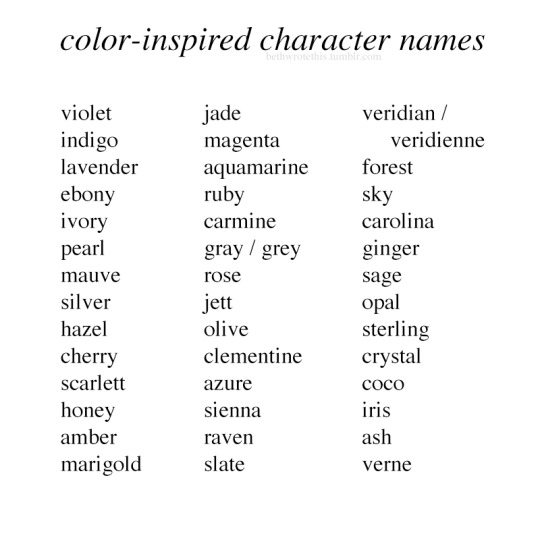
another edition of characters names! this time featuring names inspired by colors! i like the shortened version of some of these too, like indigo/indie, scarlett/scar, marigold/mari. anyways, use as you please :)
344 notes
·
View notes
Text
How to write sexual tension in YA
Finally… the long awaited sequel to “If real life were like YA fantasy”! This is what I’m sure you all REALLY want to hear about… how to develop sexual/romantic tension in YA! Your romance is boring? You want to add a little sPiCe? Well, I have studied only the best and most popular YA fiction and I am here to teach you the secrets of the trade.
First of all, you have to have an enticing male lead. If you want your readers to be turned on, you have to describe every possible aspect of his physical appearance. Personality comes second, in fact, female readers all have vastly different ideas of what an attractive personality is, so why limit your character? Just make him an empty shell or write that he is “mysterious” and people will impose their own headcanon of a good man upon him.
SCENT!!!
The first and most important thing to increase sexual tension is to write about the male lead’s scent. As we all know, the nasal organ is the most important factor in creating a sensual persona for your male lead. Everyone knows that men come in a variety of distinct and instantly recognizable scents/flavors such as “midnight”, “desire”, “the ocean”, “musk”, and “grape kool-aid”. Make sure you pick one or two good ones, preferably something that fits your character thematically but can’t actually be smelled in real life.
Touch
Touch is also very important in building sexual tension. From the very first time your female lead sees your male lead she should be thinking about his skin. This should only increase in frequency and intensity as the book goes on. Don’t forget that guilt is also very sexy so your protagonist should definitely hate herself for doing this, just to prove to us that despite her lust, she is Good and Pure. Never let a calm moment go to waste. Any time the pair is together and there is nothing imminently occupying the heroine’s attention, she should be thinking about how hot he is and how much she wants to touch him. Don’t forget to remind the reader whenever possible that the male lead is jacked. Your female lead should be shocked and overwhelmed to discover this when he takes his shirt off. This comes across as natural almost no matter who she is, because most people have never seen a shirtless man before.
“But!” I hear you saying. “I have never touched a man in my life! How am I supposed to write about touch?”
Never fear! All you have to do is write extremely flowery, over-wrought descriptions, and no one will ever guess the truth. For example, if a man’s fingers brush your hand, it feels like fire or ice or electricity or something. Take your pick. This is literally true and if you ever have the luxury of holding hands with your crush it will happen to you.
Remember, the purpose of touching/making out scenes is kind of like the scenes in PG-13 movies where you get to watch a couple’s naked back and shoulders in their bed. It’s not quite explicit enough to count as p*rn, but just uncomfortable enough to keep it from being family friendly. You NEED it if you want the romance to seem serious and mature.
Danger!
Of course, in any good male romantic lead, there must always be an element of danger. It’s impossible for a woman to be attracted to a man if she never feels threatened by him in any way. If she is not constantly wondering whether he will stab her in the back, the romance is boring. She ought to throw caution to the winds regardless, however, and become physically intimate with him in spite of her better judgement – how else would you know it’s true love? If she DOES end up betrayed by him, she should always be totally shocked, despite how fast she rushed into a risky situation. But don’t let him have a chance to explain himself (he is inevitably just misunderstood), it would kill the drama. This little plot twist is just a basic staple of YA romance, and you can’t write one without it.
Well, now you know the basics! Use your new knowledge wisely. :^)
822 notes
·
View notes
Text
When You Have a Large Cast of Characters
(This post assumes these characters are banded together in at least one large group and must work toward a similar goal.)
Let’s look at the main components that are important in large cast stories:
Teams and Sub-groups
The larger the cast, the more teams and sub-groups there are (or at least, the more there should be). These characters can find themselves in groups through a number of ways: similar backgrounds, random circumstances, matching beliefs/moral compass, etc etc.
Sometimes you can group them into categories that work well with tension, humorous effect, and character development. Some categories include:
the selfish lone wolves that are forced to work together
nerds who don’t communicate well
the hero-types that can’t agree on anything
long-term friends and their ragtag bunch of new allies
honestly, just think about teams from the MCU
Sub-groups are typically a must for stories with a large cast, as it expands the plot, individual characterization/development, conflict, and clarification. It staggers introductions of each character, giving them proper significance within the story right off the bat.
POV
This is a tricky thing to carry out. Multiple points of view are necessary unless you are absolutely sure you only want to follow ONE character the entire story, which is a feat in itself and probably ill-advised (but you do you). However, if you decide to use multiple POVs, you then also have to choose whether you want to carry that out through alternating first-person narratives or use third-person. First-person is going to require a more in-depth understanding of the characters’ voice and more decisions of who within each sub-group gets to narrate (as well as how reliable and involved they are). Both can be used in different ways to interconnect each group’s storyline. All personal choice.
Communication
Keep reading
2K notes
·
View notes
Note
Can I ask about the idea of the types of inner conflict ideas (desire, duty, self-concept, principles, fear, etc.) and explain them I guess? I’m a bit confused on them but I think they’ll be excellent to use in developing inner conflict.
Yes! So, the traits typically used to create inner conflict in a character, such as the ones you listed, are things that you should generally know about your character to make them as well-rounded and realistic as possible. “Inner conflict” happens when two of those traits clash. We can look at all of those in greater detail and look at examples of how you can pit them against each other.
Desire: Your character’s positive motivation, the thing that they want the most, the goal they are trying to achieve.
Duty: The responsibilities that they have, whether is is to their family, friends, their job, their religion, or whatever else they might be involved in.
Self Concept: The image one has of oneself. Keep in mind this is how they see themselves, not necessarily the truth of how they actually are or how others see them.
Fear: The negative motivator, the things your character most desperately wants to avoid.
Principles: A fundamental belief that your character or system of beliefs that your character holds as truth.
Once you have each of these tings established for your character, you can create inner conflict by sort of pitting them against each other. Sometimes, when you are developing these aspects, you find that some of them might naturally be at odds for each other.
Some examples- your character wants something desperately (desire) but in order to get it, they have to face down something that terrifies them (fear). Now it becomes a matter of which trait is stronger than the other- the desire or the fear.
Another example- duty vs. principles. The character has a responsibility to their job (duty), but then they are asked to do something that goes against this own personal values (principles.) They must then decide which is more important to them: completing their duty, or standing their ground on their principles.
One final example- self concept vs. desire. The character believes themselves to be of a certain type of person (self concept), but they take interest in something that is outside the sphere of what they thing is normal for that group (desire).
These are not the only combinations, or the only traits that work for inner conflict. In fact, using cornerstones and pillars can help develop your character and figure out what might be a good inner conflict for your character.
Also, you can create conflict by putting two of the same things against each other- for example, your character could have two conflicting desires, and then have to decide which one they want more.
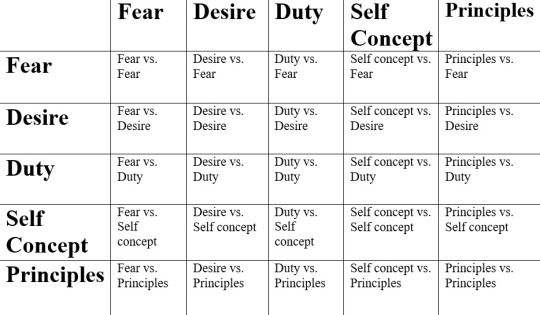
Hope that clarifies things!
- Penemue
226 notes
·
View notes
Text
Quick Plotting Tip: Write Your Story Backwards
If you have a difficult time plotting, try writing or outlining your story backwards—from the end to the beginning. Writers who have a difficult time outlining, plotting, and planning their stories often benefit from this technique. You’ll need a general idea of what your story is about for this to work, and of course you need to know the ending, but you might be amazed how helpful this trick can be.
Why is writing backwards easier? Basically, instead of answering the question “this happened… now what comes next?,” you’ll be answering the question “this happened… so what would come right before that?” which narrows the possibilities for your next move and can help keep your story on track. (Incidentally, it’s also the way Joseph Gordan-Levitt’s character comes out on top in the film The Lookout.)
Writing backwards can also help you more tightly weave together your subplots, themes, and character relationships, and keep you from going too far down any irrelevant rabbit holes.
If you don’t want to write or outline completely backwards, remember that you’re free to jump around! If you’re feeling stuck in your story or novel, jump to the middle or end and write a few scenes. Many writers get stuck because they feel they have to write their story linearly from beginning to end, which results in an overdeveloped (and often irrelevant) beginning and an underdeveloped ending.
So go work on that ending! It’s much more likely that you will need to change your beginning to fit your ending than the other way around, so spend time on your ending sooner rather than later!
10K notes
·
View notes
Text
Why You Shouldn’t Use Adverbs in Your Writing
Hi guys! It’s been a while since I’ve made an original post, but tonight I had some extra time on my hands and this popped into my head. Tonight we’re going to talk about adverbs and why exactly it is they’re frowned upon.
We’ve all heard it at least five hundred times, right? Adverbs are not your friends. It’s one of those writing mantras that just gets drilled into your head time after time until you accept it. After a while, some of us may ask ourselves, Why? Why can’t I fraternize with adverbs?
Because they’re lazy writing. You’ve probably heard that umpteen times, too. But why exactly are they lazy writing? What makes them so unbearable? I’ll tell you.
Another writing mantra that’s often shared is Show, don’t tell. In case some of you haven’t heard it, or have heard it so many times it’s lost its meaning, let me explain: basically, show, don’t tell means that it’s more effective to show reactions rather than flat-out say them. For example, instead of He was angry, you could say His jaw was clenched and his shoulders were bunched up like a prizefighter’s; instead of saying I was brimming with anxiety, you could say I felt almost seasick, my stomach broiling like a pot of noodles, and my palms were slick with sweat. That would be showing instead of telling.
One of the main problems with adverbs is that they limit a writer’s ability to show. For example, take this:
Arthur closed the door furiously and walked across the room with a snarl.
You’ll notice two adverbs: furiously and with a snarl (with a snarl is an adverbial phrase – adverbial phrases serve the same function as single-word adverbs, they just come after a comma and are prepositional phrases (things like with a grimace, after a pause, and from a distance)). Now take this:
Arthur slammed the door shut behind himself and walked across the room. His cheeks flamed, and his hands were fisted so tightly his fingernails cut into his palms.
I got rid of the adverbs, and it sounds much better than the first example: the first paints an image that’s kind of fuzzy, but the second is shown in hi-def (at least in comparison to the first). Your word count will increase a little bit if the first example is your first draft and the second example is your second, but in this case I’d say it’s worth it – the quality of your story always comes first.
Another reason adverbs are poor writing tools is that they can be redundant. Using the examples above, let’s paint a little more of the scene, to give the original lines some context:
“Arthur? Arthur, come back! You owe it to me!”
“I don’t owe you shit!”
Arthur tried to start up the staircase, but Vickie pulled him backwards – yanked him, actually. He stumbled, almost fell backwards onto the concrete, then caught his balance. He stood there, looking at her under the piss-yellow lights. Her grip on his wrist was iron.
“You owe everything to me,” she said through gritted teeth. Arthur tried to turn, but her grip only tightened. “You might have forgotten where you come from, but I haven’t, and I plan to collect on my debt.”
There was a lump in his throat that wanted to form tears, but every time he’d cried in front of her she’d turned it against him, and he wouldn’t take it anymore. “You’re asking too much, Vickie.” His voice broke, and that stung like a whip. He sounded like a kid going through puberty. “I can’t give you everything!”
“Fine.” She let go of his wrist and turned away. “Then I guess I won’t give you anything.”
He stood torn, searching for something to say, but he was pulling a blank, so he spun and ran upstairs to the relative safety of his apartment. God, who did she think she was? He was always running, but this was the last time. He’d make sure of it.
He got to his apartment and fumbled with his keys for a solid minute before he got the right one into the lock. Once he was inside, he closed the door furiously and walked across the room with a snarl.
There’s the context. Compared to all the material prior to it, the bolded sentence – the one from our first example – looks almost garish, right? Too contrived? That’s because it’s overkill. Based on the content of the previous scene, we know he’s angry; things like furiously and with a snarl are too much. They convey only one emotion: rage. From what just happened to Arthur, we know he’s feeling a lot more than pure fury.
Now reread the excerpt, but replace the bolded sentence with this: he slammed the door shut behind himself and walked across the room. His cheeks flamed, and his fists were clenched so tightly that his fingernails cut into his palms. Better, right? Yes, because it’s not redundant. The first sentence didn’t fit because it was too bold: it shoved Arthur’s anger in the audience’s face, even though that’s not the only emotion he’s feeling (or even necessarily the primary one). The second option fit better because, by showing instead of telling, it allowed room for the variety of emotions swimming in Arthur’s head (regret, anxiety, anger at both Vickie and himself, embarrassment, and probably more I’m forgetting), and didn’t keep yelling about something we’d already established.
So, to recap: we don’t use adverbs because
1. They tell instead of showing, and
2. They’re redundant. Those two reasons alone are enough to toss them out the window.
I hope this helps! - @authors-haven
6K notes
·
View notes
Text
How To Perfect The Tone In A Piece Of Writing
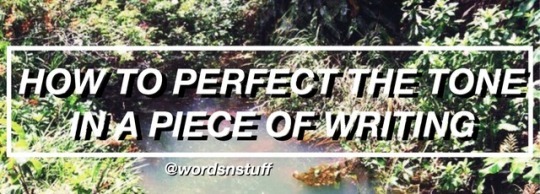
The tone in writing is one of the most important characteristics of a piece of writing. Books, poetry, songs, articles, any writing whatsoever; the tone is everything. That being said, there are a lot of ways in which writers can either mess it up or completely forget to set the tone. Below is a guide to setting the tone to come across exactly how you want it to.
Some Things To Note
Tone is the character or attitude of a text that invokes emotion in the reader
There are two things you want to ask yourself when reading a text and studying the tone:
How does the text make you feel?
and
How is the text designed to make you feel?
Things That Create Tone
There are several different elements in writing that create the tone. Here are a few:
Body Language
How your characters act, interact, and speak all play a large role in how your readers perceive your story. If your characters are speaking cryptically, fidgeting, and the tensions are high, your readers will feel the suspense.
Volume (Dialogue Tags)
How loud people say things is a big indicator of how they mean for it to come across to whomever they’re talking to. It’s the same this with dialogue. While it’s important not to overdo it with the dialogue tags, you must also use them to your advantage. It’s kind of when you’re writing a script and you sometimes feel the need to add a note for the actor to say something a certain way in order for them to portray what you envision. Use specific dialogue tags sparingly, but use them well.
Context
The context of the situation is everything. If your reader doesn’t know what’s going on and your main character is super relaxed all of a sudden when they thought they were in the middle of a very stressful situation, it’s going to give them very weird vibes. Knowing where the character is, how they feel, and having some idea of what’s about to go down is imperative to creating the right tone.
WORD CHOICE
Word choice is the main way you can set the tone in your story. You must be clear, intentional, natural, and consistent with the way you choose how you phrase things in your story. We all have certain associations with specific words and using those associations will bode well for you.
Clear Word Choice…
Be clear before anything else when setting the tone. Portray what you need to in order to create the scene itself and put the reader in the story. Then change what words you’re using in order to make the reader feel a certain way. However, never sacrifice clarity in exchange for the use of a fancy word. If your read doesn’t know what you’re saying, what good does it do anyway?
Intentional Word Choice…
Be intentional when you’re deciding where to switch out words and where you decide to really hit the reader with a huge wave of tone. Don’t just fling words anywhere there’s a gap in the hopes that it will accomplish the same thing as intentionally injecting words where it will pierce the reader’s soul. See what I mean?
Natural Word Choice
While it’s important to choose words that fit the tone, they must flow naturally with the dialogue and descriptions. Don’t just slap your reader in the face with “OMG Becky did you hear what that brat Jessica said about you and your bae? She’s such a vacuous shrew!” because that’s not exactly natural is it?
I have a whole post called Improving Flow In Writing that expands on this quite a bit.
Consistent Word Choice…
Be consistent in your word choice. Don’t use the same words over and over again, but don’t go from calling dogs to “canis lupus familiaris”. Well.. unless it’s absolutely necessary.
Examples Of Tones
Some of you might be a little fuzzy on what I mean by tone in the first place, so here are a few examples of tone:
Comedic
Suspenseful
Enticing
Desperate
Terrifying
Happy
Dramatic
Romantic
Etc.. You get the picture.
Request a prompt list/writing advice/playlist/study help post here
7K notes
·
View notes
Text
writing resources masterpost
i am just CRANKING out the masterposts. linked to original posts whenever possible. enjoy!!
100 beautiful words
name generators
plotting made simple
places to put character descriptions
guide to fantasy
how to passive voice
research resources
regular masterpost i’m including bc of all the writing/grammar links
for writers creating their own worlds/characters
who and whom how to
ways to avoid saying the word ‘very’
several ways to find the word you’re looking for
look up illegal stuff in a legal way
deflate inflated phrases
rhymes made easy
start the story
good character traits ref sheet
character traits generator
write real people
limits of the human body
best yet most infuriating writing advice
seven steps to the perfect story
100 ugly and beautiful words
quick guide to myers briggs personalities
eye shapes for writers
four temperaments
tip top writing tip
visualize your character’s house
random writing tips
castle terminology
kurt vonnegut’s rules for writing fiction
words that describe a voice
surnames/last names masterpost
random city/name generators
character building stuff
size comparison
build a realistic character
here’s why every word is important
hemingway writing checker
ideas for character flaws
if you think writing a book is easy, read this
cis person writing trans character? read this
stages of deterioration in the human body
resources for writing character bios
stuff u should know about all ur characters
22K notes
·
View notes
Text
Five places to put a physical description of your main character (without using a mirror)
1. When your main character first meets somebody they’re attracted to, their thoughts might go to the positives and negatives of their appearance.
2. Same goes for when your character is going into a situation where they feel judged (first time on a stage, moving to a new area, first day at a new job, etc.).
3. When your character is dressed up or in costume, they could take the opportunity to contrast their new look with how they look normally.
4. When your character meets a family member they’ve never seen before, they may think about which traits the two of them share.
5. Try spacing out the physical description throughout the first part of your story instead of concentrating it in one place.
5K notes
·
View notes
Photo
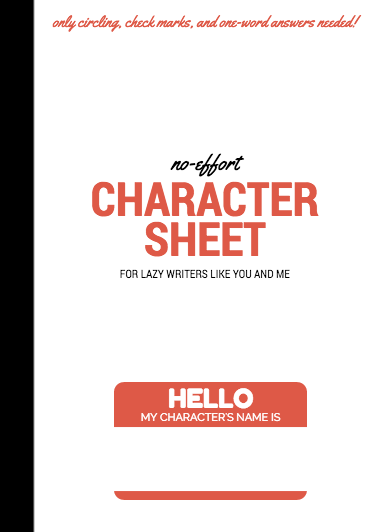

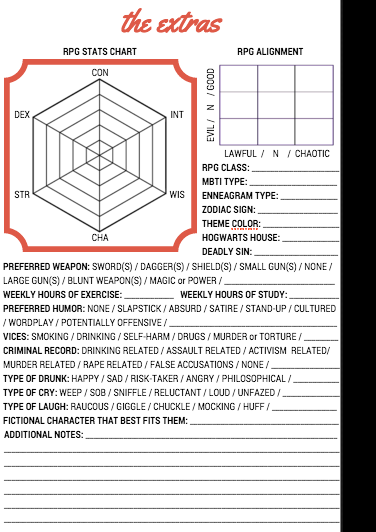
From the makers of the no-effort character checklist, I bring to you… The no-effort complete character sheet for lazy writers like you and me™!
Because the extra effort I put in staying up until 3 am to do put this together can save us all a lot of effort filling out longer character sheets ^^
You’re supposed to print it out and fold it in half to make a little booklet but you can save ink and do it on your computer :P
Link to PDF on google drive (fixed typo)
90K notes
·
View notes
Text
I am a True Believer in outlining before you write.
(At least, so long as an outline doesn’t debilitate your writing.)
But I think some people don’t understand what that means to me.
To me, an outline means that I know:
Where the story is going.
What beats it’ll take getting there.
The major content I know I want to write.
How that content can be reasonably connected.
Where character development decisions should take place.
What the climax will entail.
What choices the characters will be forced to make during the climax to fulfill or deny their developmental arc.
It also means that along the way I might…
Randomly move multiple scenes to a completely new settings.
Rearrange scenes to make for better pacing.
Throw in conversations I never imagined the characters would have.
Completely change one of my main character’s voices in the third chapter.
Have a random side character mysteriously foreshadow grudges certain characters are holding.
Realize certain characters have legitimately been holding said grudges.
Add in new character arcs for said characters to get them to work through their grudges.
Watch as the main ship progresses way faster than intended.
(Cry over the main ship.)
Let the protagonist chose to go by an alias because he’s more insecure than I thought.
Watch as his brother ruins his alias attempts four chapters later.
Create an entire new arc that revolves primarily around the protagonist wanting to sleep in a proper bed after camping for three weeks. (And do a lot of last minute plot adjusting to make the pacing still work for this bed-related arc.)
Forget one of my main characters exists for five chapters.
Suddenly add her into an arc she wasn’t supposed to be in, to make up for it.
Be bamboozled as the love interest refuses to sit still long enough to let their leg heal and ends up with a permanent injury.
Flat out re-outline entire chapters because the new idea worked better with the character development or pacing.
Realize that the symbolism I had for a certain thing has actually meant something different all along.
Add in a motto I didn’t realize was a huge part of two of the main character’s lives in the previous book.
Take about ten thousand notes on what needs to be adjusted in the next draft.
Cry because I think the novel will be too long.
Cry because I think the novel will be too short.
Cry because I love it too much.
Cry because it’s definitely the worst thing ever written.
So, when I say I’m a True Believer in outlining, I don’t mean that I’m a believer in never letting your story’s surprise you, or never making last minutes adjustments, or never throwing out huge parts of your outline for something better.
I mean that I’m a true believer in letting your story have a foundation before you write it, because any large or complex story built on a weak foundation, like a castle built in the sand, will need to be re-built later.
But the stronger a foundation you build for it, the easier it is to make changes without your entire structure falling apart.
#This is not saying that some writers don’t do better just rebuilding the castle later or that all stories are complex enough to warrant outlines. #Please do not take my post about what outlining means to me and attempt to writer’splain to me how some writers can’t use outlines. #I literally put that disclaimer right below the title. #Read and think before you reply.
9K notes
·
View notes
Text
Making your angst hurt: the power of lighthearted scenes.
I’m incredibly disappointed with the trend in stories (especially ‘edgy’ YA novels) to bombard the reader with traumatic situations, angry characters, and relationship drama without ever first giving them a reason to root for a better future. As a reader…
I might care that the main siblings are fighting if they had first been shown to have at least one happy, healthy conversation.
I might cry and rage with the protagonist if I knew they actually had the capacity to laugh and smile and be happy.
I might be hit by heavy and dark situations if there was some notion that it was possible for this world to have light and hope and joy to begin with.
Writers seem to forget that their reader’s eyes adjust to the dark. If you want to give your reader a truly bleak situation in a continually dim setting, you have to put them in pitch blackness. But if you just shine a light first, the sudden change makes the contrast appear substantial.
Show your readers what light means to your character before taking it away. Let the reader bond with the characters in their happy moments before (and in between) tearing them apart. Give readers a future to root for by putting sparks of that future into the past and the present. Make your character’s tears and anger mean something.
Not only will this give your dark and emotional scenes more impact, but it says something that we as humans desperately, desperately need to hear.
Books with light amidst the darkness tell us that while things are hard and hurt, that we’re still allowed to breathe and hope and live and even laugh within the darkness.
We as humans need to hear this more often, because acting it out is the only way we stop from suffocating long enough to make a difference.
So write angst, and darkness, and gritty, painful stories, full of treacherous morally grey characters if you want to. But don’t forget to turn the light on occasionally.
Support Bryn’s ability to provide writing advice by reading their debut novel, an upbeat fantasy about a bloodthirsty siren fighting to return home while avoiding the lure of a suspiciously friendly and eccentric pirate captain!
41K notes
·
View notes
Text
Dos And Don’ts Of Dialogue
Dialogue: either you’re great at it, or it’s your worst nightmare. Writing dialogue can be difficult, confusing, and frustrating. Here are some tips to clear the air when it comes to dialogue!
DON’T overuse dialogue tags

From the very beginning, writers are often told not to overuse “said”. While this is sound advice, it can create the false notion that “said” is never to be used. This simply isn’t true!
Stay away from repeating creative dialogue tags one after another, especially if it’s redundant. For example, if there’s an exclamation point after a sentence, you don’t need to say that the character exclaimed or yelled.
Often, a dialogue tag isn’t even needed. Just end the dialogue without a tag.
DO use “said”

Repeat after me: IT IS OKAY TO USE “SAID”!
I’m guilty of this one as well. The urge to not use “said” too often becomes a habit of never using it and replacing it with unnecessary dialogue tags.
Just use said! It will make your writing seem far more mature than if you used something like “growled” or “stated”.
DON’T go on tangents
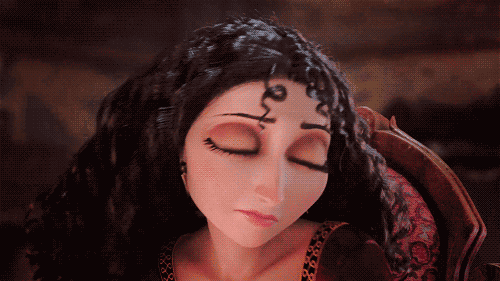
Dialogue should be realistic. If you have a character that is known for going off on tangents, then by all means do so. If you’re going on a tangent to seem “artistic”, you might want to cut it off there.
My biggest pet peeve with modern young adult literature is that writers try to combing their need to prove they can write beautiful prose with dialogue. Don’t. In the end, it’s just unrealistic and a cheap way of trying to show your talent. Leave the long-winded metaphors for your narration, please.
DO use unique speech

Everyone speaks differently. This could mean accents, slang, catchphrases, or misused words. Include this in your dialogue!
Colorful dialogue creates colorful characters, and allows the reader to be able to easily distinguish who is speaking (without dialogue tags!).
DON’T overuse phonetics

Though accents can be a great way to create colorful dialogue, phonetically spelling every word according to the character’s accent can get annoying fast. Stick to spelling out the most important words. After a while, the reader should be able to read that character’s dialogue with their accent in mind anyway.
DO show, not tell
Every writer has received this advice at one point or another, but with good reason. Dialogue is the best way to put “show, don’t tell” into practice. However, writers often think that dialogue itself counts as showing. Though dialogue is a better tool than description in these instances, it doesn’t completely serve as a way to show on its own.
Telling: “Hey, calm down. You look nervous.”
Showing: “Hey, calm down. You haven’t stopped tapping your foot since we got here.”
DON’T repeat names too often

I too fall into the trap of constantly clarifying who is speaking. When you’re writing, it feels natural to say things like “’How are you doing, Jim?’ ‘I’m doing well, Pam.’”, but the reality is that no one speaks like that, especially to people they’re close to.
Most of the time, you should use names in dialogue tags and greetings. Otherwise, use names sparingly.
8K notes
·
View notes
Text
Every scene furthers the plot.
Some writers confuse “you must further the plot with every scene” with “heavy plot handling must happen constantly.” (Which is a shame, because the latter is not only incorrect, but can make your character’s interactions stiff and boring.)
It’s okay to let your characters joke.
It’s okay if they get off track of the plot relevant conversation.
It’s okay if not every scene is a big plot reveal.
It’s okay to just have fun sometimes.
What is the idea behind “every scene furthers the plot” then? Why is it actually important?
“Every scene furthers the plot” can be better described as “every scene reminds the reader why this story is important and either provides a plot relevant point of tension or makes them anticipate a plot relevant tension to come.”
Most readers will read through anything as long as they anticipate something to come. If you don’t give them anything to anticipate (and remind them they’ll reach that thing if they keep reading) then they have very little preventing them from putting the story down at the end of that scene.
The last thing we need to remember here is that character development should be highly integrated with your plot, and constantly effecting and being effected by your plot, until the point where they are nearly synonymous terms. As such, your plot integrated character development is often enough ‘plot’ to tide over a few otherwise 'plotless’ scenes.
Support Bryn’s ability to provide writing advice by reading their debut novel, a lighthearted fantasy about a bloodthirsty siren fighting to return home while avoiding the lure of a suspiciously friendly and eccentric pirate captain!
2K notes
·
View notes